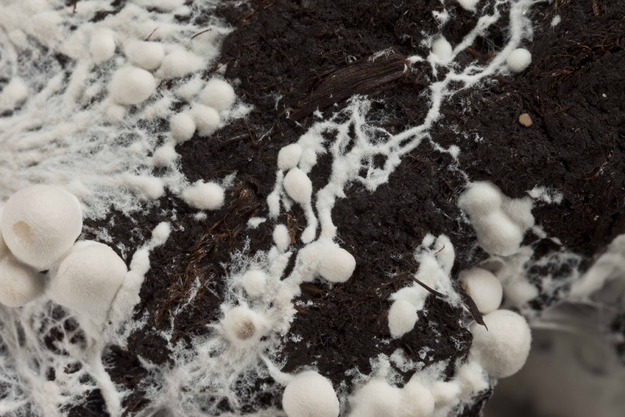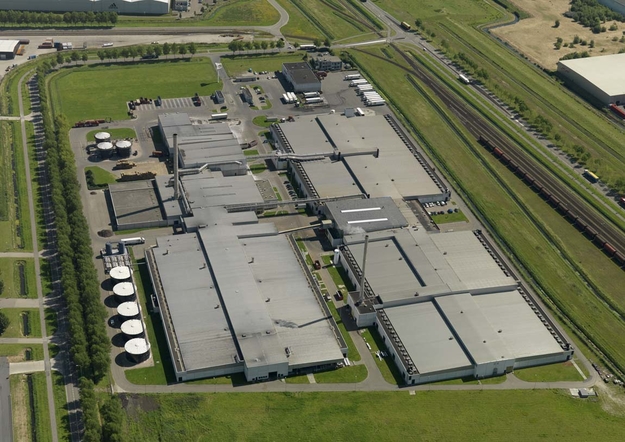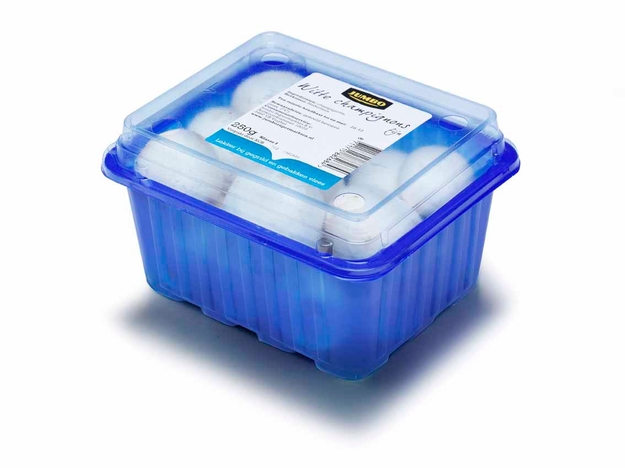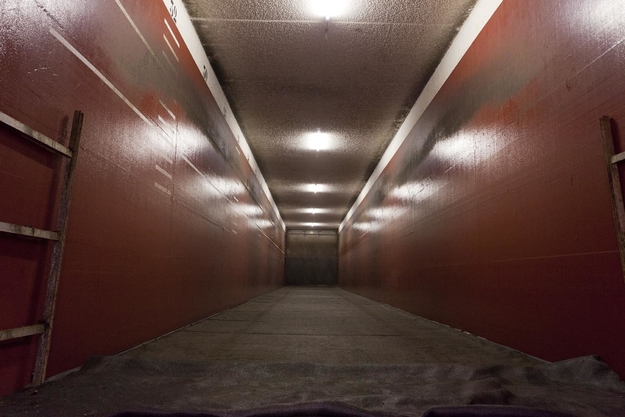CNC is a Dutch company that has specialized in creating the substrate on which Agaricus bisporus, the so called white button mushrooms, grow. The corporation grew out of necessity when mushroom farmers realized that the production of substrate was a complicated process that could be done better economically by centralization of the production. The growers joined forces and created CNC, a company that today produces more substrate than any other company in the world and, together with its cooperation, holding C4C and daughter companies, operates in all parts of the mushroom production chain.
So what is this substrate? Substrate is a complex mixture of straw, manure and gypsum which goes through a special process to make it a suitable habitat for mushrooms. The process of creating substrate at CNC consists of three phases. It starts with hundreds of trucks bringing fresh manure to the facilities every day. Mostly horse manure is used. It is used because it is a waste product and usually already contains high enough percentages of straw to make it directly usable for substrate production. The trucks dump the manure in large closed spaces. Wheel loaders continuously toss the manure around to aerate and mix it. Mixing is paramount throughout the entire process and will be repeated several times later on.
Substrate with Agaricus bisporus - Substrate with Agaricus bisporus at CNC Holding
When the manure is sufficiently homogeneous, it is loaded onto enormous conveyor belts that move the substrate to the next step. In this step, if the straw content is too low, additional purchased straw is added to balance the mixture. This is done in a specially developed, fully automated process that cuts the straw, softens it, aerates it, and mixes it in a homogenous way with the manure. All in one machine!
Phase 1
The manure now enters phase one of the CNC process. It is loaded into giant concrete tunnels where it is let to rest in a closed environment. Again this is done by a custom developed cascading distribution mechanism that ensures an even and homogenous spreading of substrate in the tunnels. As said before: mixing is all!
Normally in the process of growing mycelium or mushrooms, one needs to remove all the malicious organisms, such as bacteria or other ‘bad’ fungi, from the substrate to make sure that the fungus you actually want to grow grows, and no other. Normally this involves pasteurization, sterilization. However when the manure is allowed to rest in a closed environment the composting action is so high that the substrate gets aggressive enough of itself to ‘kill the bad guys’. The temperature rises to nearly 80 ˚C and industrial grade ventilators are needed to keep the oxygen level up. Literally, the shit hits the fan in this phase!
The manure get so heated by bacterial activity that the straw is starting to decompose. The waxy layer that encloses straw stalks is weakened and softened so that the fungus can later on have easy access to the yummy cellulose inside the straw stalks.
Phase 2
When the substrate has been sufficiently bombarded with ammonia and high temperature, it is allowed to cool down to a nice 25 ˚C and can move on to the second phase. In this phase the substrate is inoculated by a mixture containing organisms (Scytalidium) that opens up the substrate and makes it especially habitable for Agaricus, the fungus that spawns white button mushrooms. During this phase the substrate again heats up to 60 ˚C and a lot of material is burned by the organic action.
Phase 3
When the actinomycetes have rolled out the red carpet for the Agaricus bisporus , the substrate moves to phase three. It is cooled down to 25 ˚C by ventilation and is inoculated with pregrown Agaricus spawn. After the inoculation, the spawn will colonize the substrate inside the tunnels, which are kept at a controlled temperature and oxygen level. After 16 days the spawn is fully grown and is extracted from the tunnels to be shipped to the growers.
The growers spread the compost onto racks in environments with controlled humidity, temperature and oxygen levels. The substrate is then covered by a layer of casing soil. This layer simulates certain conditions that tell the substrate that it’s the right time and place to start making mushrooms. Usually two harvests of mushrooms can be gained with a layer of substrate and casing soil. When the mushrooms have been picked, the substrate is used as fertilizer for fields and pastures where it can stimulate the growth of new straw, which is the first step in the next cycle of substrate production.
C4C Holding aerial - C4C Holding in Milsbeek, The Netherlands
Challenges
CNC has created a process that produces high quality substrate and is fully sustainable. However, there are some challenges that need to be tackled in the future. For instance, the leftover spent mushroom substrate after mushroom picking, the ‘Champost’, is legally a fertilizer and in the Netherlands can only be used in small amount by farmers. To find other applications for it is an ongoing quest for the entire industry.
Also, most of the production process was developed empirically and very little of the actual causes and results are known. This means more research into the precise workings of fungi, organic composting and mushroom growth is needed.
Caroline van der Horst is R&D manager for the C4C holding. She is interested in alternative application of substrates and in process innovations for the production of substrate.
Rob van der Burg is an intern at Mediamatic currently working on finding alternative applications for mushrooms. Particularly the vegetative part of the mushroom, the mycelium, proves to be interesting as a material in art and design.
Robert Lelivelt is currently graduating at the Eindhoven Technical University at the unit Structural Design. The aim of his thesis is to test and asses the possibilities of using mycelium as a building material.

